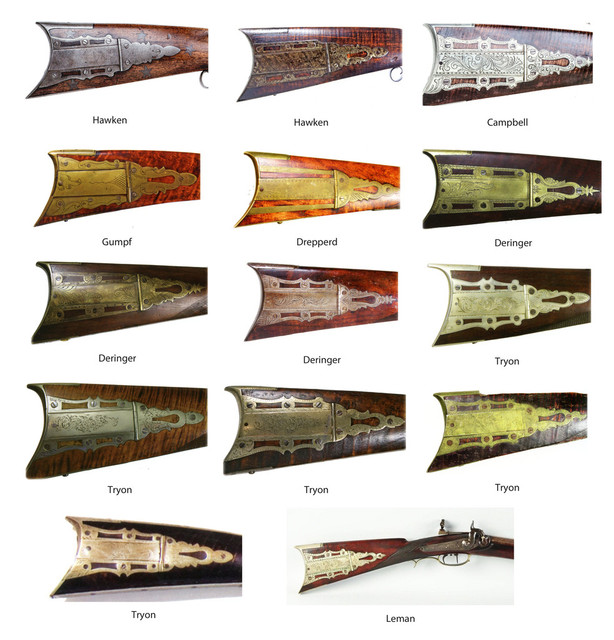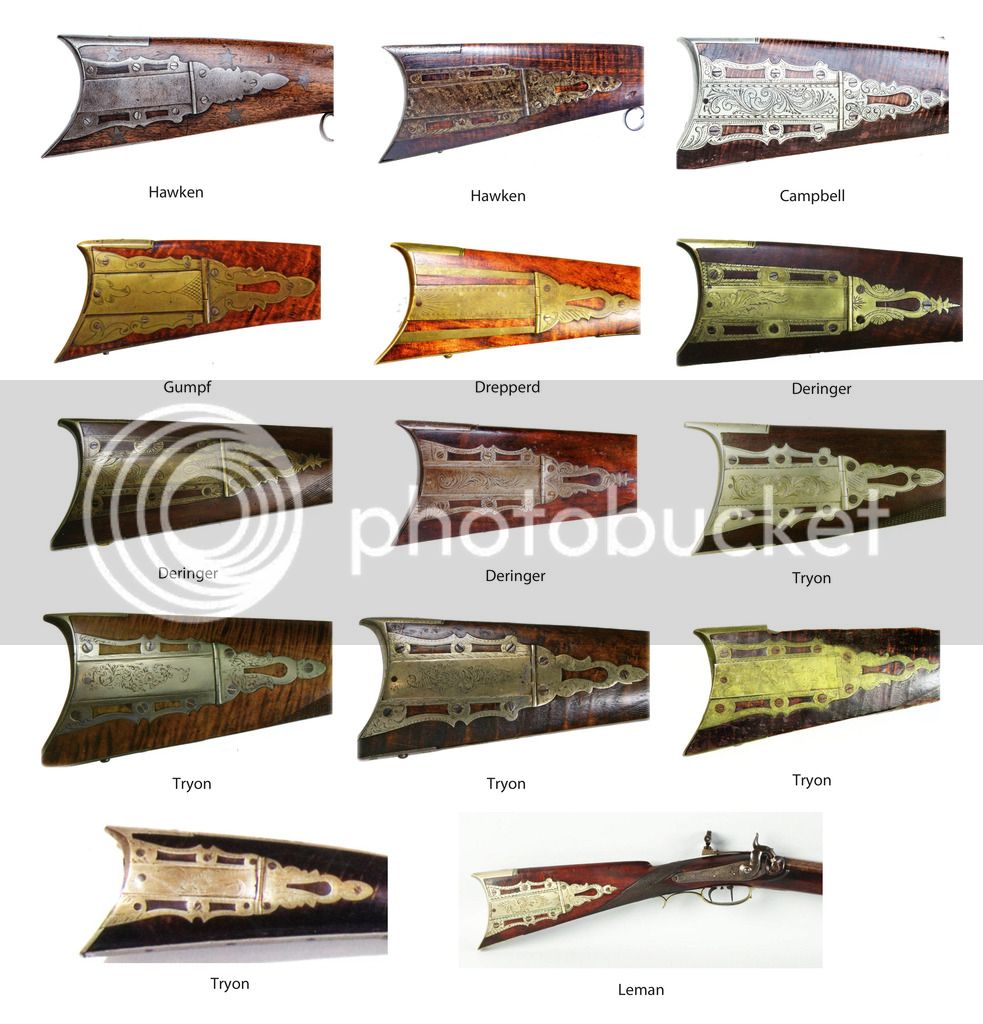Plmeek, where did you find this reference for these Patchboxes? The one one the top left is Nearly identical To one I am copying.I can tell only so much from pictures, so I offer a few opinions.
I see no evidence that the lock was ever a flintlock. The square or clipped tail on the lock plate is a characteristic of a late Henry Leman lock of the percussion period. There is an extra hole in the lock plate near the nose. This appears to be the stud hole for the original main spring that was on the lock. I believe the lock has a modern replacement mainspring which required drilling a new hole in a slightly different location.
There are two lock bolt holes in the lock plate bolster suggesting this lock has been on another gun or older stock.
Henry Leman normally marked the rifles his company made on the lock and on the barrel. Since you didn't find any marks on barrel, I suspect that someone other than Leman made this gun or another possibility is that this is a relatively modern parts gun assembled from antique and possibly modern parts.
The "unknown holes drilled into the top of the barrel" suggest that a peep sight or even a scope had been mounted on it. This was sometimes done in the middle of the 20th century when interest in muzzleloaders and black powder shooting was beginning a revival, but before reproduction guns were widely available. People often shot antique guns or fabricated shoot-able guns from antique parts.
The original rear sight dovetails appear to have been filled. One with iron or steel and another with a copper colored metal.
It's hard to tell, but it is possible that the stock is modern. I notice the color of the wood in the lock mortise is about the same as the fresh wood exposed in the broken wrist. I would be interested in seeing pictures of the wood under the butt plate and in the barrel channel.
You didn't mention if the barrel is rifled or smoothbore. The octagon to round barrel isn't common on rifles of this period. Does it look like an antique or modern barrel?
I would also like to see pictures of the bottom of the barrel showing the front half of the bottom flat. Looks like there might be some other extraneous holes there that might tell us more about its history.
The patch box only has two screws holding it on and these are in the finial. The two side plates appear to have nails holding them on. This style of patch box was used by a number of different gun makers, including Henry Leman, but most used screws to hold the side plate on as shown in the montage below.

It's hard to tell from the pictures alone whether this is an antique patch box or a modern reproduction.
Anyway, just some observations.
-
Friends, our 2nd Amendment rights are always under attack and the NRA has been a constant for decades in helping fight that fight.
We have partnered with the NRA to offer you a discount on membership and Muzzleloading Forum gets a small percentage too of each membership, so you are supporting both the NRA and us.
Use this link to sign up please; https://membership.nra.org/recruiters/join/XR045103
You are using an out of date browser. It may not display this or other websites correctly.
You should upgrade or use an alternative browser.
You should upgrade or use an alternative browser.
Pawn Shop H. Leman Rifle ID
- Thread starter Soxlocke
- Start date

Help Support Muzzleloading Forum:
This site may earn a commission from merchant affiliate
links, including eBay, Amazon, and others.
plmeek
40 Cal.
Most of these pictures of PB's on various rifles are from Jim Gordon's Great Gunmakers for the Early West three volume set. A couple may be from images I pulled off the internet from auction houses. I combined individual pictures to form the montage. My original intent in putting the montage together was to show that this style of PB was used on a wide range of rifles by different makers across several "schools". I believe that Tryon sold these PBs in the day, though some gunmakers may have made their own from scratch. The top there guns are by St. Louis gunmakers. Gumpf, Drepperd, and Leman were Lancaster gunmakers. Deringer and Tryon were Philadelphia gunmakers.
The PB in the top left is on the Mariano Medina Hawken. Photos of this rifle have been published in a number of books including James Hanson, Jr.'s The Plains Rifle, and John Baird's Hawken Rifles: The Mountain Man's Choice. The rifle used to be on loan and exhibit at the Colorado Historical Museum in Denver, but they decided to down play guns and the winning of the west and opted not to buy the rifle when the family that owned it wanted to sell. Jim Gordon ended up buying it from the family and now has it in his collection in New Mexico.

A version of this patch box is commercially available at Muzzleloader Builders Supply -- Part #11141 - Modena Hawken - Steel.
The PB in the top left is on the Mariano Medina Hawken. Photos of this rifle have been published in a number of books including James Hanson, Jr.'s The Plains Rifle, and John Baird's Hawken Rifles: The Mountain Man's Choice. The rifle used to be on loan and exhibit at the Colorado Historical Museum in Denver, but they decided to down play guns and the winning of the west and opted not to buy the rifle when the family that owned it wanted to sell. Jim Gordon ended up buying it from the family and now has it in his collection in New Mexico.

A version of this patch box is commercially available at Muzzleloader Builders Supply -- Part #11141 - Modena Hawken - Steel.
Matter of fact I found your Photobucket image of different patchboxes used on Hawken rifles.Most of these pictures of PB's on various rifles are from Jim Gordon's Great Gunmakers for the Early West three volume set. A couple may be from images I pulled off the internet from auction houses. I combined individual pictures to form the montage. My original intent in putting the montage together was to show that this style of PB was used on a wide range of rifles by different makers across several "schools". I believe that Tryon sold these PBs in the day, though some gunmakers may have made their own from scratch. The top there guns are by St. Louis gunmakers. Gumpf, Drepperd, and Leman were Lancaster gunmakers. Deringer and Tryon were Philadelphia gunmakers.
The PB in the top left is on the Mariano Medina Hawken. Photos of this rifle have been published in a number of books including James Hanson, Jr.'s The Plains Rifle, and John Baird's Hawken Rifles: The Mountain Man's Choice. The rifle used to be on loan and exhibit at the Colorado Historical Museum in Denver, but they decided to down play guns and the winning of the west and opted not to buy the rifle when the family that owned it wanted to sell. Jim Gordon ended up buying it from the family and now has it in his collection in New Mexico.
View attachment 55799
A version of this patch box is commercially available at Muzzleloader Builders Supply -- Part #11141 - Modena Hawken - Steel.

thats exactly what I have been looking for, thank you. I didn’t know I could have purchased it already cut outMost of these pictures of PB's on various rifles are from Jim Gordon's Great Gunmakers for the Early West three volume set. A couple may be from images I pulled off the internet from auction houses. I combined individual pictures to form the montage. My original intent in putting the montage together was to show that this style of PB was used on a wide range of rifles by different makers across several "schools". I believe that Tryon sold these PBs in the day, though some gunmakers may have made their own from scratch. The top there guns are by St. Louis gunmakers. Gumpf, Drepperd, and Leman were Lancaster gunmakers. Deringer and Tryon were Philadelphia gunmakers.
The PB in the top left is on the Mariano Medina Hawken. Photos of this rifle have been published in a number of books including James Hanson, Jr.'s The Plains Rifle, and John Baird's Hawken Rifles: The Mountain Man's Choice. The rifle used to be on loan and exhibit at the Colorado Historical Museum in Denver, but they decided to down play guns and the winning of the west and opted not to buy the rifle when the family that owned it wanted to sell. Jim Gordon ended up buying it from the family and now has it in his collection in New Mexico.
View attachment 55799
A version of this patch box is commercially available at Muzzleloader Builders Supply -- Part #11141 - Modena Hawken - Steel.
Similar threads
- Replies
- 9
- Views
- 485
- Replies
- 53
- Views
- 4K
- Replies
- 7
- Views
- 429



